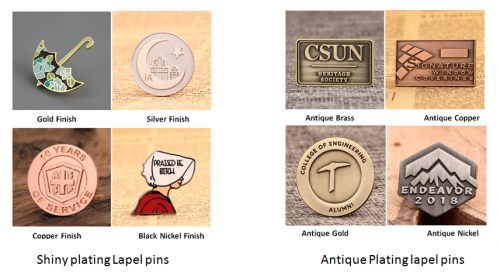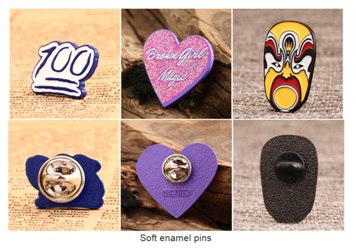Do you know which craft of the Custom Pins is protective? Electroplating should be the best-known lapel pins protection process. There’s actually another way, which is spraying. Electroplating (covering a layer of other metals), spraying (whole product is sprayed with a layer of paint, and the coverage area is the same as electroplating). Now let me show you the difference.
Electroplating: Electroplating is a process that a metal coating is added to the surface of a carrier, such as gold, silver, copper, nickel, and other metallic materials. Through the movement of atoms, metals join with metals. Electroplating can prevent metal oxidation, improve wear resistance, corrosion resistance, and aesthetic enhancement. To the lapel pins, different electroplating on the pins protection is the same, and the main difference is its aesthetic impact.
- Advantages:
1. Good uniformity and strong binding force of the coating
2.Wear resistance and corrosion resistance
3. A beautiful metallic appearance
- Suitable for custom pins:
- Shiny platings: gold, silver, copper, nickel, black nickel, etc. This kind of electroplating is suitable for Soft Enamel Pins, Hard Enamel Pins, and Die struck pins with sandblasting.
- Antique Platings: Antique brass, Antique Gold, Antique Copper, Antique nickel. This kind of electroplating suits to lapel pins with the old appearance. For example, Antique pins and 3D or Cutout Pins.

Spraying: Spraying is used as the air pressure of spray guns that disperses liquid paint into uniform and fine droplets and then covering on the surface of the carrier. The spraying on the enamel pins is to spray different colors of paint on the metal surface. The paint is attached to the pins, and the binding force is weaker than the electroplating. (electroplating: the combination of metal and metal).
- Advantages:
1. You can choose any color other than metal color at will.
2. The price is the same as metal electroplating lapel pins
3. The coating is thicker than metal plating
- Suitable for custom pins: Soft enamel pins

Attention- Spraying cannot be used in hard enamel pins
Q&A:Why hard enamel pins can’t use the Spraying process?
Because of the different workmanship, the hard enamel pins are filled with enamel color and then need to polish, after the polish to electroplate. And the soft enamel pins that can use spray paint craft is, add electroplating layer or coating first, after on enamel color, and then complete already, need not polish. For example: if hard enamel pins are spraying black paint(dye black finish) before filled enamel color, then the black paint will wear off after polishing. If you fill enamel color and polish first and then spray black paint, the filled enamel color will also be covered with a layer of black paint. It will cause the whole lapel pins to be black.
Suggestion:
If you want the dye black effect of your custom pins, you can choose the black nickel plating.

After reading above, how about doing a quiz to consolidate the knowledge you’ve learned?
Yes, the or False?
- Is there only one kind of plating process for the protection of the lapel pins?
- Can the soft enamel pins use the Spraying process?
- Can the hard enamel pins use the Spraying process?
Surely you can answer these three questions correctly? If not, go back to the above to find the answer!

According to me, electroplating is better than the spraying, it is long lasting and effective for the product too but in spray, you can get options, So we can say both have their own advantage and they are suitable to according the product, Thank you for sharing an awesome article.
I’m not that much of a internet reader to be honest but your sites really nice, keep it up!
I’ll go ahead and bookmark your website to come back later on. All the
best
I discovered your blog site through my social media–
it’s now in my bookmark list!
Hey there, just wanted to tell you just how much I enjoyed
your post. Maintain the great!